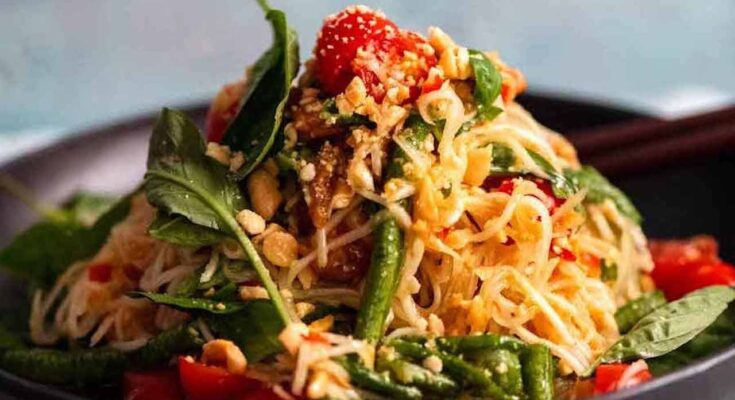Green Papaya Salad Recipe: Ever craved a salad that delivers a crunchy texture, tangy burst, and fiery kick all in one bite? Meet Green Papaya Salad – a culinary masterpiece from Southeast Asia, loved not just for its bold flavors but also for its simplicity and health benefits. Known as “Som Tum” in Thailand and “Tam Mak Hoong” in Laos, this salad is a favorite among food lovers who enjoy spicy, sour, and savory dishes.
The magic of green papaya salad lies in its fresh, raw ingredients pounded together to create a dynamic mix of textures and flavors. Think crunchy papaya strips, juicy tomatoes, spicy chilies, salty fish sauce, and a sweet note of palm sugar. Served traditionally as a side dish or a light meal, it’s become a global favorite at Thai and Lao restaurants.
But here’s the good news: you don’t need to travel far to enjoy it. With just a few key ingredients and some kitchen basics, you can whip up this flavor-packed dish right at home. Ready to bring Southeast Asian street food to your kitchen? Let’s get started!
Health Benefits of Green Papaya Salad
This isn’t just a salad that tastes great—it’s one that your body will thank you for too. Green papaya, the star of the show, is a nutrient powerhouse. It’s loaded with vitamin C, vitamin A, fiber, and digestive enzymes like papain that help break down proteins and support gut health.
Here’s a breakdown of the health benefits:
- Digestive Boost: Thanks to its enzyme content, green papaya helps improve digestion and prevent bloating.
- Weight Management: Low in calories and high in fiber, this salad can keep you feeling full longer, making it perfect for anyone watching their weight.
- Anti-Inflammatory Properties: Ingredients like lime juice, garlic, and chilies contain antioxidants and anti-inflammatory compounds that can help fight inflammation.
- Heart Health: Fish sauce (used in moderation) offers a bit of omega-3s, while the high veggie content keeps cholesterol levels in check.
- Immunity Support: With its vitamin C and antioxidant content, it gives your immune system a natural boost.
So, the next time you dig into a bowl of this zesty salad, know that you’re not just satisfying your taste buds—you’re doing your body a favor too.
Ingredients You’ll Need
Before diving into the step-by-step process, let’s gather the essential ingredients. Green papaya salad requires simple, fresh ingredients that are easy to find in Asian grocery stores—or even regular supermarkets in some areas.
Main Ingredients:
- Green Papaya (1 medium-sized): Firm and unripe; avoid the yellowish, ripe ones.
- Cherry Tomatoes (1 cup): Halved or quartered.
- Garlic (3-4 cloves): Crushed for bold flavor.
- Fresh Red Chilies (2-5): Adjust to your heat tolerance.
- Lime Juice (2-3 limes): Freshly squeezed.
- Fish Sauce (2-3 tablespoons): Provides the umami depth.
- Palm Sugar (1 tablespoon): Adds sweetness; substitute with brown sugar if needed.
- Roasted Peanuts (¼ cup): Crushed for texture.
- Green Beans (½ cup): Cut into 2-inch pieces.
Optional Add-ons and Variations:
- Dried shrimp: Adds a salty, umami-rich crunch.
- Crab or fermented fish: For a more traditional Lao touch.
- Carrots or cucumbers: Extra crunch and color.
- Vegan version: Replace fish sauce with soy sauce or vegan fish sauce.
Having everything prepped and within reach before you start pounding and mixing will make the process smoother and more enjoyable.
Tools and Equipment Required
Traditionally, Som Tum is made using a large wooden mortar and pestle, which is perfect for bruising and blending the ingredients without turning them into mush. But don’t worry—if you don’t have these tools, you can still make a delicious version at home with a few creative swaps.
Traditional Tools:
- Clay or wooden mortar (pok pok): Deep enough to hold all ingredients without spilling.
- Pestle: Usually wooden or stone, used to crush and blend the salad.
Modern Alternatives:
- Large mixing bowl + muddler or wooden spoon: Use to gently crush and mix the ingredients.
- Julienne peeler or mandoline: To shred the papaya into thin strips.
While you won’t get the same texture or authenticity without the mortar and pestle, you can still replicate most of the flavor and crunch with the right techniques.
Step-by-Step Preparation Guide
Let’s walk through each step of making this vibrant salad, from choosing your papaya to serving the final dish.
Step 1: Selecting the Right Green Papaya
The key to a great papaya salad is using the right kind of papaya. You’re looking for an unripe green papaya—firm to the touch with pale green skin and white flesh inside. Ripe papayas will be too soft and sweet for this dish.
Tips for selecting green papaya:
- Look for heavy, firm fruits with no soft spots.
- When cut, the inside should be crisp, white, and seedless or with immature white seeds.
- If you can’t find green papaya, try using green mango or kohlrabi as substitutes.
Once you’ve picked the perfect one, peel off the skin with a vegetable peeler. Then, use a julienne peeler, mandoline, or knife to shred it into long, thin matchstick strips. These strips should be firm enough to hold up under the pounding process without turning mushy.
Step 2: Prepping the Vegetables
Now that your papaya is shredded and ready to go, it’s time to prepare the rest of the veggies. This step is where your salad gets its bright color, juicy bite, and extra crunch.
Start by washing and trimming your green beans. Cut them into 2-inch pieces. Blanching is optional, but if you prefer a slightly softer texture, you can boil them for 30 seconds and cool them in ice water. Otherwise, keep them raw for a fresh crunch.
Next, grab a handful of cherry tomatoes, preferably red or orange for a vibrant look. Slice them in half or quarters depending on their size. Tomatoes release their juices into the salad, helping blend and balance the spicy, salty, and sour notes.
Garlic cloves are best crushed or finely chopped. They add depth and a pungent kick that ties the whole salad together. Likewise, chilies (usually Thai bird’s eye chilies) should be pounded or sliced thin. Don’t overdo it unless you want to sweat through your lunch—start with two and go up from there.
Once your ingredients are chopped, shredded, and ready to go, set them aside near your mixing station. The prep stage is crucial—it ensures everything is at your fingertips once you begin combining and pounding the salad.
Step 3: Making the Dressing
The soul of green papaya salad is its dressing—a flavor-packed combination of sweet, sour, salty, and spicy. This is where the magic happens, turning raw vegetables into a dish bursting with complexity.
Here’s the classic blend for the dressing:
- 2 tablespoons fish sauce
- 2 tablespoons fresh lime juice
- 1 tablespoon palm sugar (or brown sugar)
- 1-2 chopped Thai chilies
- Optional: 1 tablespoon dried shrimp
To make the dressing, start by dissolving the sugar in the lime juice and fish sauce. You can do this directly in the mortar or in a separate bowl if you’re mixing by hand. Add the chilies and garlic, and gently pound to release their flavors into the mixture.
Taste your dressing. It should hit all four flavor notes—spicy, salty, sour, and sweet—in harmony. If it feels off, adjust it:
- Too salty? Add more lime juice or sugar.
- Too sweet? Add lime juice and fish sauce.
- Too sour? Add a touch more sugar or fish sauce.
Once you get it just right, you’re ready to mix in your veggies and shredded papaya. This dressing will coat everything, soaking into the ingredients and elevating them with every bite.
Step 4: Mixing and Pounding the Salad
Now for the fun part—putting it all together. This step combines everything into that iconic green papaya salad experience.
If you’re using a mortar and pestle, start by adding the garlic, chilies, and green beans. Gently pound them to bruise and release their flavor. Next, add the tomatoes and dried shrimp (if using), pounding just enough to slightly crush the tomatoes and blend everything.
Add the shredded papaya and pour in your dressing. Continue pounding gently while using a spoon to toss and mix. The key here is gentle bruising, not smashing. You want to blend the flavors and soften the texture without turning it into a mush.
If you don’t have a mortar and pestle, don’t worry! Use a mixing bowl and the back of a wooden spoon or a muddler to press and mix the ingredients together. You’ll still get great results.
Once everything’s well combined, sprinkle on the crushed peanuts and give it a final toss.
Step 5: Serving Suggestions
Green papaya salad is best served fresh, as the flavors and textures are most vibrant right after mixing. Traditionally, it’s served as a side dish, but it can easily be the star of the show with the right pairings.
Serve with:
- Sticky rice: A classic pairing in Thai and Lao cuisine.
- Grilled meats: Like Thai BBQ chicken, beef satay, or pork skewers.
- Spring rolls: Fresh or fried rolls make a perfect companion.
- Fried tofu or tempeh: For a vegetarian meal with protein.
For presentation, pile the salad high on a plate or shallow bowl. Garnish with extra peanuts, lime wedges, and a few whole chilies for color. You can also add lettuce or cabbage leaves on the side to use as edible scoops.
And don’t forget a cool drink—iced tea, coconut water, or even a light beer to tame the heat and complement the bold flavors.
Pro Tips for the Best Flavor
Getting green papaya salad right isn’t just about following a recipe—it’s about mastering the balance of flavors. The best Som Tum hits you with spicy heat, salty depth, tangy freshness, and just a touch of sweetness. Here’s how to fine-tune it to perfection.
1. Always Taste and Adjust: The biggest secret of any Thai-style dish is constant tasting. After you mix the dressing, try a small spoonful. If one flavor overpowers the others, tweak it. Thai cuisine is all about that magical harmony.
2. Use Fresh Lime Juice Only: Bottled lime juice doesn’t even come close to the brightness and punch of freshly squeezed limes. It’s non-negotiable if you want that authentic zing.
3. Don’t Over-Pound: If you’re using a mortar and pestle, be gentle. You want to bruise, not crush, the vegetables. The idea is to release flavors and allow the dressing to soak in, not mash everything into pulp.
4. Let It Sit for 5–10 Minutes: After mixing, let the salad sit briefly. This resting time helps the flavors meld and the papaya absorb the dressing, resulting in a more cohesive taste.
5. Toast Your Peanuts Fresh: Freshly roasted peanuts add a warm, nutty crunch that pre-packaged nuts just can’t replicate. Toast them in a dry pan until golden, let them cool, and crush them lightly before adding.
6. Add Dried Shrimp Last-Minute: If you’re using dried shrimp, sprinkle them in just before serving so they retain their crunchy texture and ocean-briny punch.
Experiment and don’t be afraid to customize. Some like it sweeter, others spicier. The beauty of this dish is how easily it adapts to your personal taste.
Common Mistakes to Avoid
Even though green papaya salad is a simple dish, a few common missteps can turn your crunchy, tangy masterpiece into a flavor flop. Here are the mistakes you should steer clear of:
1. Using Ripe Papaya: It’s called green papaya salad for a reason. Ripe papayas are soft, sweet, and mushy—not suitable for this dish. Always pick unripe, firm, green ones.
2. Over-Mashing the Ingredients: A heavy hand with the pestle will break down the texture too much. The vegetables should be lightly bruised, not turned to mush. This keeps the salad crisp and vibrant.
3. Skipping the Sugar: It might seem optional, but sugar is crucial for balance. It softens the acidity and saltiness. Without it, your salad could taste too sharp or one-dimensional.
4. Using Bottled Dressing:
Pre-made sauces and bottled dressings often contain preservatives and lack the bold, fresh flavor of a homemade mix. It takes just a few minutes to whip up your own dressing—don’t skip it.
5. Not Adjusting to Taste: This dish is all about balance, and every lime or chili pepper is different. Always taste as you go and make small adjustments to achieve that perfect harmony.
Avoid these pitfalls and your green papaya salad will be every bit as good as what you’d find on the streets of Bangkok or Vientiane.
Variations Across Southeast Asia
While the Thai version of green papaya salad, known as Som Tum, is the most internationally recognized, this dish takes on different forms across Southeast Asia. Each region adds its own twist based on local flavors, ingredients, and traditions.
Thai Som Tum (Thailand):
This is the most common version you’ll see in restaurants. It’s spicy, sweet, tangy, and often includes crushed peanuts, dried shrimp, tomatoes, and long beans. The dressing usually features lime juice, fish sauce, palm sugar, and chilies.
Tam Mak Hoong (Laos):
The Lao version is funkier and often spicier. It typically includes fermented fish sauce (padek) and more chilies. It may also use local herbs and skip the peanuts, focusing instead on raw, unfiltered flavors.
Bok L’hong (Cambodia):
Cambodians enjoy their version with a bit more sweetness and often add crab or fermented shrimp paste. The papaya is sometimes mixed with other vegetables like cucumber or carrots.
Vietnamese Goi Du Du:
This variation is a milder, more herbaceous salad often served with grilled beef or shrimp. Vietnamese fish sauce (nuoc mam) is lighter, and the dressing leans more toward the sweet-savory balance.
Exploring these regional takes can help you find your favorite—or inspire your own signature style.
Pairing Ideas and Serving Options
Green papaya salad is more than just a side dish—it’s a versatile culinary chameleon that pairs beautifully with a wide array of foods. Whether you’re planning a casual lunch or a fancy dinner, this zesty salad can steal the spotlight.
1. With Grilled Meats: Pair it with grilled chicken, pork skewers, or Thai BBQ beef. The spicy, sour salad cuts through the richness of the meat, making for a balanced and satisfying meal.
2. Over Jasmine or Sticky Rice: For a more filling dish, serve it alongside jasmine rice or sticky rice. The starch helps mellow the heat and adds substance to the meal.
3. In Lettuce Wraps: Spoon the salad into butter lettuce or cabbage leaves for a refreshing appetizer or low-carb snack. Top with crushed peanuts or herbs for extra crunch.
4. With Seafood: The citrusy notes go amazingly well with grilled or steamed fish, shrimp, or squid. A little salad on the side turns a simple seafood dish into something exotic and elevated.
5. As a Light Main Course: Add grilled tofu, tempeh, or seared shrimp to bulk up the salad and turn it into a full meal. You’ll still keep it light but protein-packed.
6. Beverage Pairings: Cool off with Thai iced tea, lemongrass soda, or even a crisp lager. These drinks complement the spicy heat and keep your palate refreshed.
FAQs about Green Papaya Salad Recipe
1. Can I use ripe papaya instead of green papaya?
Not really. Ripe papaya is soft, sweet, and juicy, which completely changes the texture and flavor profile of the salad. Green papaya is crisp, neutral, and firm—perfect for soaking up the dressing and holding its crunch.
2. Is green papaya salad vegan or vegetarian?
It can be! Just skip the fish sauce and dried shrimp. Use soy sauce, tamari, or a vegan fish sauce alternative. The result is still incredibly tasty and full of vibrant flavors.
3. How long does green papaya salad last in the fridge?
Ideally, it should be eaten fresh for the best texture and flavor. However, you can store leftovers in an airtight container for up to 24 hours. The salad will soften a bit, but the flavors will still be delicious.
4. What if I don’t have a mortar and pestle?
No worries. Use a mixing bowl and a wooden spoon or muddler to bruise and mix the ingredients. While the texture might differ slightly, the flavor can still be spot-on.
5. Can I make the salad less spicy?
Absolutely. Just use fewer chilies—or skip them entirely if you’re sensitive to heat. You can also deseed the chilies to tone things down. The salad will still be flavorful with the lime, garlic, and fish sauce combo.
Conclusion
Whether you’re making it for a summer picnic, a healthy lunch, or a spicy side to a BBQ, Som Tum fits right in. It’s customizable, forgiving, and a total crowd-pleaser once you master the balance of flavors. Plus, it’s packed with nutrients and digestive enzymes, making it just as good for your body as it is for your taste buds.
If this is your first time trying green papaya salad, don’t be intimidated. Follow the steps, use fresh ingredients, and trust your taste buds. Once you’ve made it a couple of times, you’ll start putting your own spin on it—and that’s where the real fun begins.
Ready to impress your friends or treat yourself with a dish that packs a punch? Green papaya salad is waiting for you.



